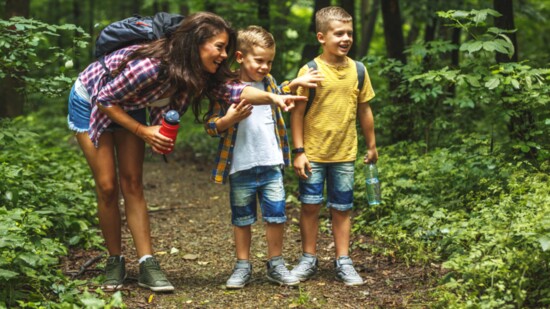What better way to spend quality time with your family and get in touch with nature than a fresh, invigorating walk in the woods, along a river, or the beach? What’s more, family hikes make for fun learning opportunities for kids and parents alike. So try some of these hiking activities with your youngsters.
A stone is a stone is a…mineral?
Go on an excursion to learn about rocks and minerals. Shorelines offer a variety of stones. Before you go, learn which rocks and minerals are abundant in the area, and have each family member choose several to scout for. Take along a small plastic container with dividers, a descriptive rock and mineral guide, and a magnifying glass for viewing the colors, layers, and details. As you identify stones and minerals, discuss their uses and other neat facts.
Sounds of nature
Wander through a forest and listen carefully for a variety of bird and animal sounds. Before you go, check out YouTube or visit your library for a DVD or audio CD of birds and wild animal calls. Then, download an audio recorder on your phone and carry it on your hike to record some of the sounds you hear. Listen to the recording again at home and play a game of detective to determine the source of the sounds you can’t make out. Search the internet and books to discover the makers of the mystery calls.
Photo adventure
Capture nature’s splendor. Hiking trails provide plenty of photo opportunities, and kids will love snapping the shots. Discuss in advance what each family member wants to photograph, such as a huge oak tree, a monarch butterfly, deer tracks, or a close-up of a nibbling squirrel. When you get home, print out the best photos and create a nature scrapbook with them.
Creepy crawly things
Scouting for insects is an all-time favorite among kids, and the variety of creepy-crawly creatures in the woods is remarkable. Carry an insect book, clear container, tweezers, and a magnifying glass for a close examination of insects’ fascinating features. Bring a journal and track the types of insects you find. Read about insects’ defense behaviors and characteristics, such as colors that indicate danger to predators.
Which way do we go?
Roam the neighborhood or local trails and teach your children directional skills, such as how to read a map and use a compass or the sun to determine direction. Before setting out, choose a trail system that provides maps or make up your own. Take a trail that branches off several times, allowing for plenty of skill-building opportunities. For even more fun, turn the excursion into a treasure hunt and go Geocaching or hide a small prize just off the trail yourself, mark the location on your map, and let the journey begin.
Plantlife, old and new
Discover with your kids the fantastic diversity of plant life. Before you head out, review some books on plants to spark your children’s interest. On each hiking trip, choose a different trail or area and see what plants grow in certain types of soil, climates, and in each season. As you inspect plants, look for their seeds and notice the variations. Talk about how seeds travel by blowing in the wind or catching on the fur of animals. Carefully brush away the ground cover and look for seeds that have sprouted their roots that will soon develop into a new plant or tree. Learn how individual plants have evolved to have natural defenses to protect against creatures that would otherwise devour them.
Now, you’re ready to hit the trails for a fun and unforgettable hiking experience with the whole family. Lake Minnewashta Regional Park, Lake Waconia Regional Park, and Baylor Regional Park are great places to start exploring, and many offer their own programming and activities that are great for all ages.
Trekkin’ tips for tykes
When hiking with children, keep these suggestions in mind.
- Allow small legs plenty of time for breaks and making the journey, and know your child’s limitations.
- Be familiar with potential dangers in the area in which you’ll explore and teach your children trail and animal safety.
- Before you set out, prepare your kids by informing them that there may be rules against taking their nature finds home.
